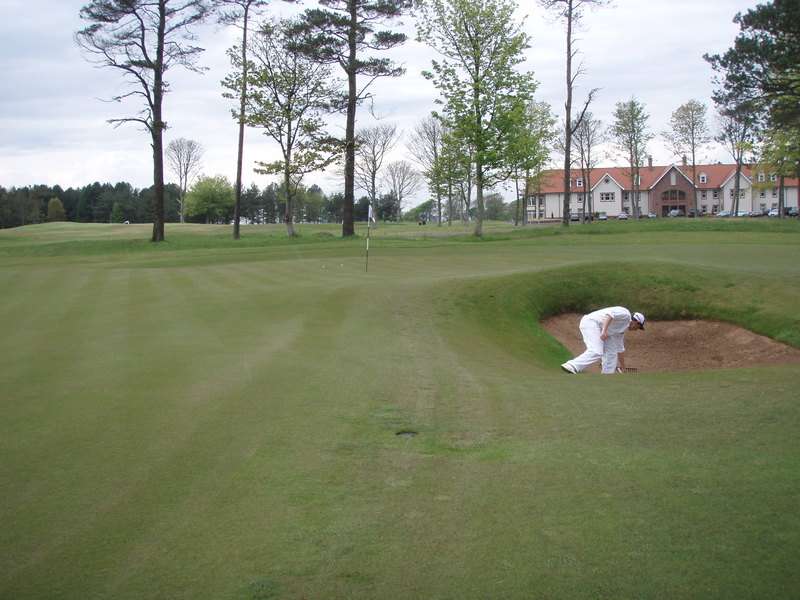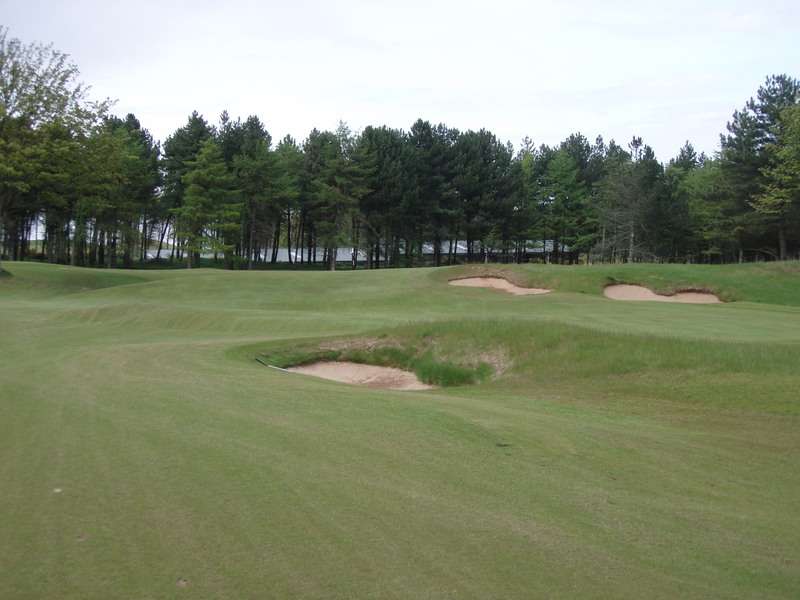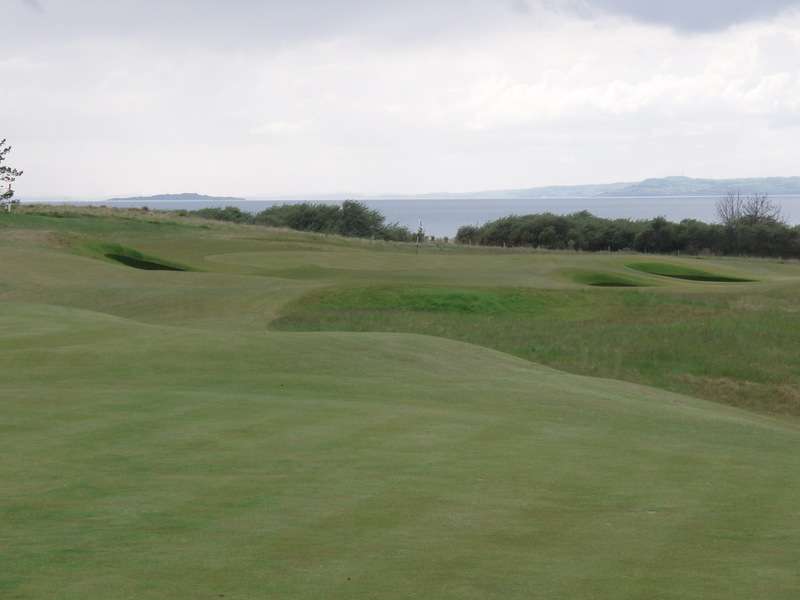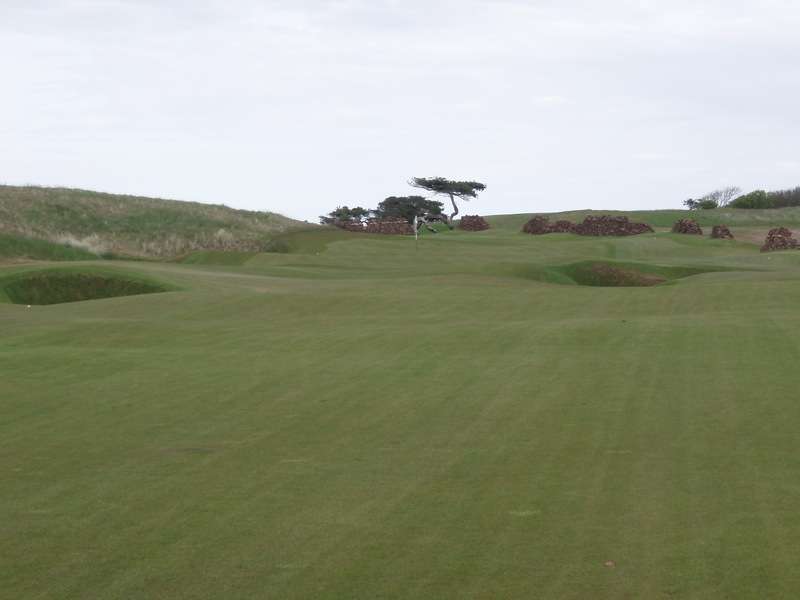
The "L"-shaped 3rd green features a bunker set in its elbow that collects misplaced balls from the putting surface

Doglegging right, the 7th invites you to try a tee shot threaded between the right side bunkers and the centreline hazard to shorten your second to a tricky ridge-top green
The 9th is an attractive par three played towards the Firth of Forth, with the severity of the green hidden from view: a rear tier drops away sharply, making it hard to get close to a back pin
A massive mound short right of the 10th green dominates the strategy of the hole, creating - in tandem with the back downslope - one of the best greens on the course
The 11th green slides naturally off a dune, creating slopes around the putting surface that send the imagination into overdrive with a chipping club in hand. The lone tree standing sentry at the back is just one of the examples of Doak aligning landmarks and features with the greens
The green complex is a highlight of the brilliant 16th, with its confounding slopes, devilish bunkering and panoramic views out over the previous holes
My favourite par three was the 17th, which plays between 160-odd and 200+ yards depending on your choice of tee and has its surface sunk below the level of the ridge in front of the green. As with the 11th there are options aplenty around the green for recovery shots, with a strong slope visible at the back of the green helping to feed the ball on
Course name: The Renaissance
Location: Dirleton, East Lothian, Scotland
Four Word Course Review: I'm on a Doak!
For the past decade Tom Doak has been the king of golf course design, turning out a succession of the world's best new courses - Pacific Dunes, Old Macdonald and Ballyneal in the USA, St Andrews Beach and Barnbougle Dunes in Australia and Cape Kidnappers in New Zealand among them.
Until now, I'd not experienced first-hand what the masses have raved about. After playing The Renaissance Club, his first UK design, I am a convert. Although Renaissance is not spoken about as being among Doak's best three or four, that's no insult, in fact it's probably the golf design equivalent of being a middle-tier Victoria's Secret model!
Knowing Doak is a fan of using width, short grass and wild greens to challenge the golfer, I was expecting to like what I saw, but even that prior knowledge hadn't prepared me for just how wide those fairways would be, how much fun could be had on and around the greens and how many different angles could come into play.
After an inland loop of eight holes that returns to the clubhouse, the final 10 are set in an "M" shape, close to the Firth of Forth and tumbling over far more dramatic land than the opening stretch is blessed with.
That said, the front half holds its own with some great visual deception, appealing greensites and strategic options, as well as some subtle undulation over otherwise flat land.
At the permieter of many greens are slopes that will deflect anything not on the right line, with bunkers and sloped chipping areas waiting to collect the ball as it's swatted away from the hole: among the best examples is the putting surface feeding straight into a bunker set at the elbow of the "L"-shaped 3rd green.
With a chipping club or putter in hand, the greens are so playfully difficult that anything less than great shot planning and execution will be punished. I say "playfully" difficult because even when you are having your heart broken by them, they are so much fun to play.
Generally I found the slopes separated pretty sedate sections of green. If you hit an approach into the same sector of the green as the pin, the putts had surprisingly little break in them. Speaking from my own experience and listening to our forecaddie discuss lines with my playing partners, rarely did such a putt have more than a couple of balls' worth of break, a foot or so perhaps on a 20-30 footer. The massive break came when you'd played your approach or recovery shot to the wrong area of the green.
The width of some holes has to be experienced to be believed. Rarely have I seen such bad places to hit your ball within the fairway cut. It takes some careful concentration from the tee to select where to place your shot, because there is often no obvious visual difference (ie. sand or long grass) between position A1 and purgatory.
Bold landforms are a feature of several holes - a fairway kickpad to buy you some extra length off the tee on the 6th, a ridge atop which the tricky 7th green is set, an awe-inspiring green at the 10th that I'll describe in more detail later and the 12th greensite, which offers vast views over the back nine, the firth and Edinburgh in the distance.
On the 8th you play over an ancient stone wall for the first time, a relic of the land's previous use, as is the case down the road at North Berwick. The hole is full of great features: the wall, rumpled ground and a steep false front ensuring the approach, although likely to be played with a pitching wedge or less, will punish anything not well planned or executed.
The stone walls are also utilised at the 11th, where one flanks the green to the right, and the 18th, where it plays a part in the second shot whether you're laying up near it or trying to clear it. Two new holes (more of that further down) will also interact with a wall.
Bunkerless beyond the driving zone, the 10th has an all-world greensite, guarded short right by a massive mound that both blocks your view from the right of the fairway and kicks forward anything landing short of the green. Behind the green is a downslope of similar ferocity that will account for a shot struck too strongly. Unless you can manage to park your second shot hard left, the mound will dominate your choice of shot for the approach.
It's in the middle (and possibly the best) of a run of six consecutive brilliant greens (7-12), each very different to the others.
In this part of the round is where three new holes are to be built on a firth-side strip that was recently acquired in a land swap with Muirfield's governing Honourable Company of Edinburgh Golfers (which wanted woodland behind Renaissance's 10th tee to extend its 9th hole for The Open Championship).
Two par threes will play parallel in opposite directions to adjacent greens located either side of a stone wall, while a par four will run east along the water's edge.
From there a hole playing from the current 12th fairway to the 13th green will be built, replacing the par four 12th and par three 13th currently in play.
Further to that, there are plans to build a new par three in woodland behind the 15th, allowing the 16th to become a short par five rather than a mid-length two-shotter. The current line of thinking is that the first three holes will be taken out of play to accommodate the new holes, but I am told that is not yet definite.
So despite the course's youth, a lot of change is on the immediate horizon.
As it stands, the 16th was perhaps my favourite hole on the course: the drive played over a left-to-right sloping hill that becomes blind the further you hit it. A centreline bunker and right-hand bunker need to be split for the best angle in to a green that drops to the left and is guarded on that side by sand.
The land short of the green also leans towards the firth, giving you the impression that the green will also kick the ball that way, but it's an optical illusion. Also, the greenside bunkers are perhaps the deepest on the course.
Generally, the bunkering felt to me that it got deeper and more brutal as the round wore on, something Tom Doak has revealed was governed not by a desire to increase the challenge gruadually, but by a higher water table on the inland holes that come earlier in the round.
If The Renaissance Club left me feeling something was lacking, it was perhaps those one or two unique, memorable shots that you replay in your mind after the round. Perhaps the new holes, with their enviable land, will fill that void and allow the course to hit a crescendo it deserves.
But that's a small factor next to the wonderful interest, fun and variety that is my lasting impression of The Renaissance Club.





No comments:
Post a Comment